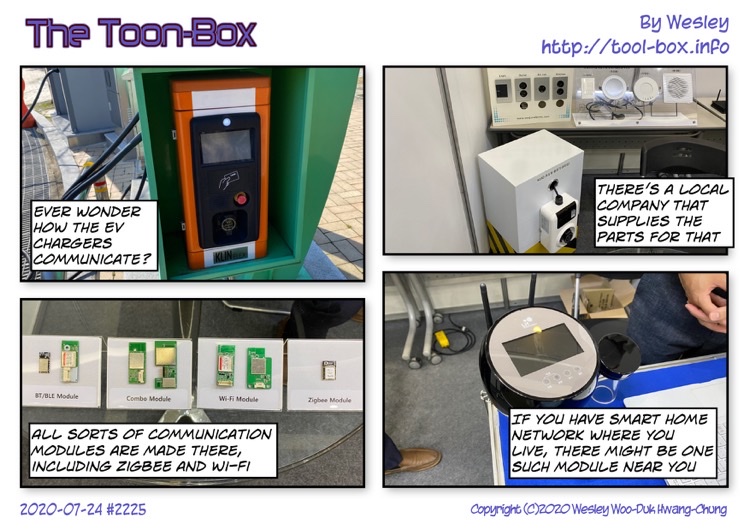Entries tagged as smart meter
Bluetooth camera iPhone 6S Plus remote control electricity LG Prada 3.0 Seojun Electric adapter Apple Watch battery belt case cable charger GPS lightning Micro-USB pen iMac repair USB Gangneung lamp Starbucks LED emergency KPX news summer television winter EMS K-EMS Naju New EMS Wesley Woo-Duk Hwang-Chung fluorescent light light fixture TopLux Sigma LED air conditioner FLIR One IoT smart plug socket wire Apple TV 4th Gen Elgato Eve HomeKit Incipio Koogeek Leviton lights Philips Hue power plug power switch sensor Celine Chung Hayun Chung playground Sejong slide MIFARE NFC RFID Apple Store Japan Osaka A1687 3D Touch screen screen protector 3DMark Geekbench iPhone 3GS iPhone 4 iPhone 4S iPhone 5 iPhone 5S iPhone 6 Plus Octane SunSpider Touch ID A1522 A1524 A1530 A1533 A1549 A1586 A1633 A1634 A1688 iPhone 6 iPhone 6S LTE VoLTE PeaceKeeper astronomy Celestron NexStar 6SE telescope artificial star collimation Sony A5000 electric fan light trail M&M's BuyBeam BL-628 assembly kit box Bolt EV car Chevrolet electric sanitizer ultraviolet department store Seoul Shinsegae beam projector Dongwon toy tuna ballast galaxy star KBS concert MITs-M4300 performance Swing Live Fest SBS EBS KTV coaxial cable EyeTV Gwangju Mac mini baseball game home run Sung-Eun Kim Bitgaram City election rain satellite TV shower water crypto currency electronics kit Yongsan bus hockey ice ice rink Olympic and Paralympic Games cabin filter outlet cleaning building convenience store infrared thermal imaging road 3D printing corn dog hot-bed hot-end microwave restaurant spaghetti Dawon DNS SK Telecom Witty 11st smart button App Store iPhone X PSAurora refrigerator Samsung weather degree CR2450 switch air purifier park IKEA store AT&T Cortex Camera Kraken iPhone 5C KT LGU+ VoIP barometer Focus Pixels iOS 8 iPad iPad mini Reachability Chungjang-ro iPhone 6+ KEPCO solar panel travel construction lake BHC chicken blizzard snow Lotteria Canon SX50 HS ISS satellite New Year's Day snow angel fog Cajun Fries Mom's Touch Thigh Burger contamination food truck Chappie Gwangju Songjeong Station Megabox movie movie theatre smog Burger King farm garden coffee shop sidewalk Gochunaengi pork cutlet sushi animation Larva shopping cart expressway traffic jam commute Makibox balloon car wash engine oil gas station Tamiya wheel headlights Sonata 2 KIXX PAO BIXPO Daepoong DE101 exposition drone ESS car inspection Gangnam Hyundai Parnas Samseong Seolleung snowman demonstration COEX mall Wi-Fi sweet potato hotel stadium tower Korea Institute of Energy Technology relocation cabinet monument broiled eels eel server book library KTX-Sancheon meal box wind turbine cellphone JooN 2 watch Europe Korea O2E Smart Multi-Charger UK USA watchOS 2 shopping National KP-55 Panasonic pencil sharpener Ioniq Nexo Soul EV Daepoong emart CarPlay iOS 12 air pump foot pump tire
Today's "The Toon-Box"
Posted by Wesley on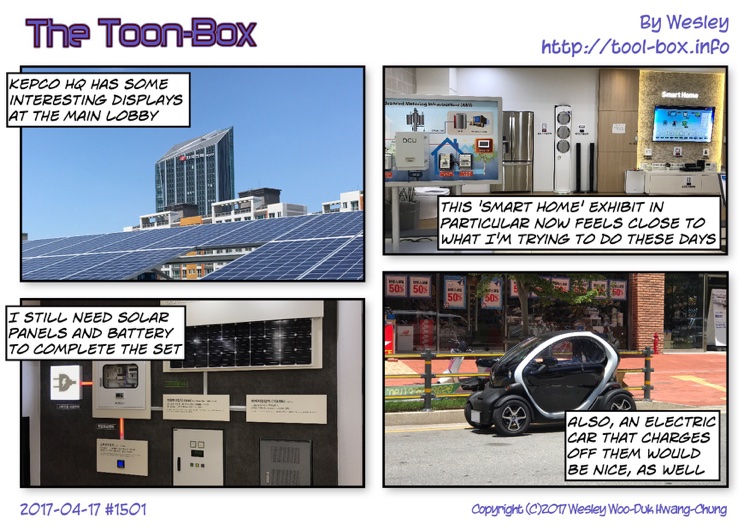
SKT Smart Home: Tale of two smart plugs (Witty & Dawon)
Posted by Wesley on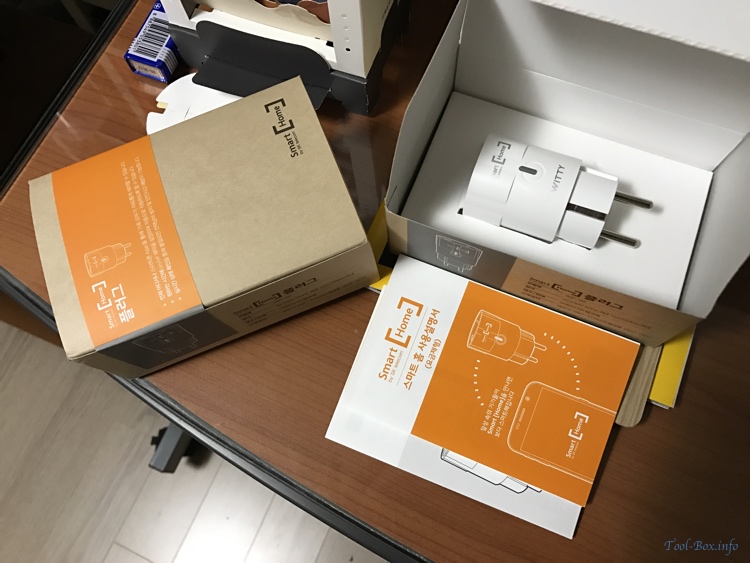
Smart Plug "Witty E" WIP-02A, unboxed
Lots of companies are hopping on the wave of Internet of Things (IoT) these days, each trying to build an ecosystem of their own. Major Korean mobile carriers (SK Telecom(SKT), KT, and LGU+) are no different, each setting up proprietary efforts. I used to largely ignore them because they required monthly fee, ranging from a few dollars per device to tens of dollars for "unlimited" (discounted with multi-year contract). With many non-carrier solutions usable without fees, I felt this to be undesirable.
However, SKT must have felt that this arrangement was hurting their chances for wide acceptance, because it began offering some of their affiliated products free of monthly fees, charging only a nominal (KRW 5,500, US$4.80) one-time fee included in the sales price since last October. I decided to take the bait and started integrating their home IoT products, sold under the "SKT Smart Home" brand, into my house. The very first one was a smart plug. The one you see here is the one made by Witty.
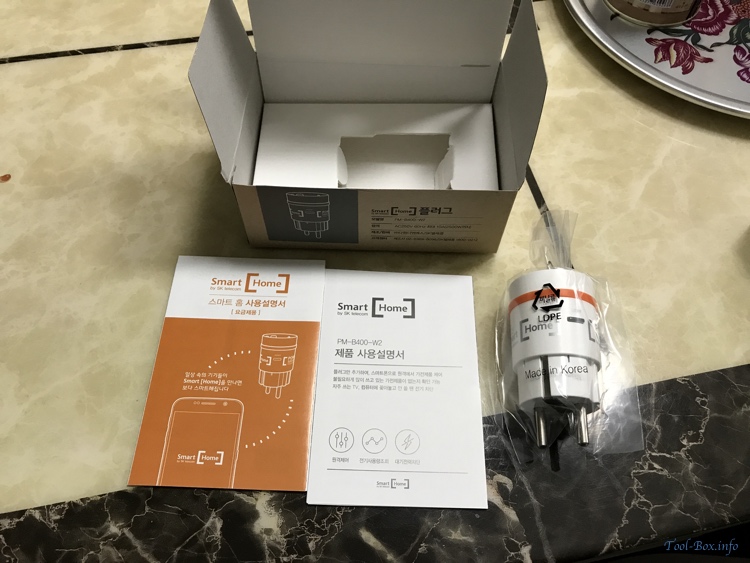
Smart Plug "Dawon Power Manager" PM-B400-W2
Over time, I installed several of these plugs around the house and some of them came from another company, Dawon DNS. Because SKT was selling them, lots of things were made to be nearly identical, namely the packaging and the functionality. The frugal-looking brown paper boxes contain the plug and the instruction manuals, all of which look almost exactly the same except for the diagram of the plug. Both companies' plugs are controlled by the one and the same official app, and works largely like as if they are the same product.
Even the price is similar, at around $22.50 to $26, which makes them one of the most inexpensive options. This includes the aforementioned fee, so the pricing is rather aggressive. The deal is made even sweeter by the fact that the plugs do not need any gateways or hubs to operate as some other solutions do (namely that of other carriers'). It will interface directly via Wi-Fi, so if you already have a wireless router at home there's no additional cost involved.
Tracking down electricity draw (Part 4)
Posted by Wesley on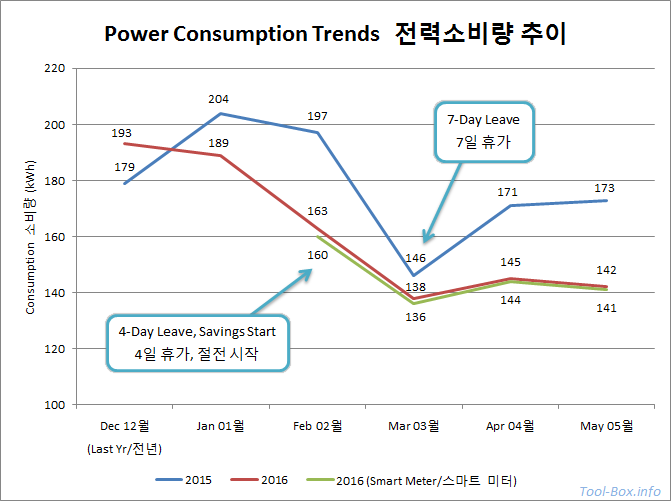
Comparison of the electric power consumption trends between 2015 and 2016
It's been about five months since I installed Seojun Smart Meter at home and took various measures to cut down unnecessary electricity use. Now was a good time to see if the smart meter was recording monthly data accurately, and whether my efforts panned out well. This graph sums up everything that needs to be said.
In terms of accuracy, the smart meter consistently reported slightly lower than the default meter installed in the premise. However, it is more less in line with the advertised margin of error (1%) after the initial month and thus I think it's reliable. This is important because the companion app effectively shows last month's finalized data a full month before it shows up in the bill, and the app also shows the forecast for this month. Now I know that these values can be trusted and I can prepare two months ahead.
Moving onto the consumption trends, my home generally spent around 190 to 200kWh in winter, then fell down to the 170kWh range in spring if the family didn't go out on a vacation. This is already somewhat below average for a 4-person family, but I started making the house even less wasteful starting in February this year by making more efficient use of the appliances and changing the lightings and bulbs to LED. Eventually, it has settled to somewhere between 140 to 150kWh per month now. This is a saving of roughly 30kWh, or more than 15%.
Thanks to this and being much more aware of the consumption in real time, I'm expecting about 30% savings in electricity costs in the summer when the air conditioning is in full operation. Home electricity rates in Korea is pseudo-exponential, so you pay a lot less for seasonal increase if you start out from a lower baseline. Recently, I helped my dad cut down power use at his house by lowering the baseline by roughly 200kWh and I think it'll save him at least US$300 per month during summer. I'm expecting that the money that went into the streamlining will pay for itself in 3 years. Overall, I'm satisfied with the results of the efforts I put in.
Tracking down electricity draw (Part 3)
Posted by Wesley on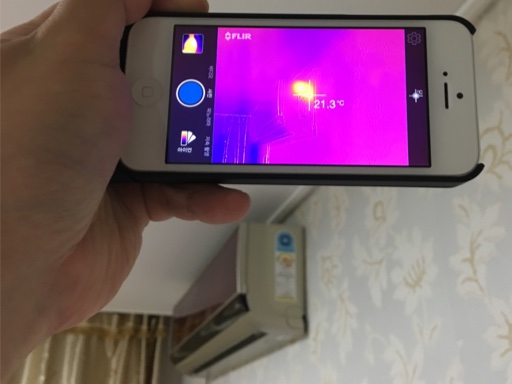
Thermal imaging shows the air conditioner's standby power turning into heat
As the hunt for even more potential waste of power continued, I brought in the help of thermal imaging technology. By scanning each place with a thermographic camera attached to an iPhone (FLIR One; I'll write about this later) I can find any hot or cold spots that seem to be out of place.
One of such "hot" spots I found was on the side of an air conditioning unit. It wasn't being used, but standby power drawn from the wall outlet was slightly heating up the control circuit and was readily visible via thermal images. I could just pull the plug until summer, but I decided to take a step further.
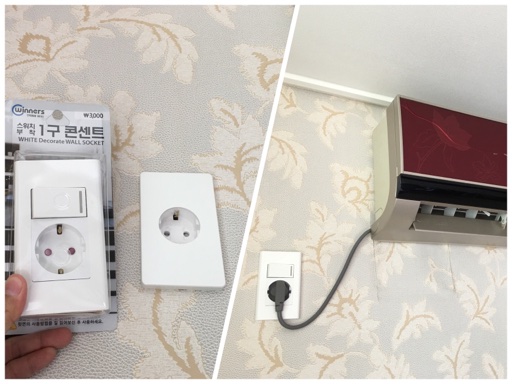
Installing a wall socket with a switch so the air conditioner won't use standby power
I replaced the default wall outlet with the one that had an integrated switch. This way, I could cut the power from the outlet with a switch when the air conditioner isn't in use, instead of having to pull the plug. Not only would this be simple to operate, it would avoid the mechanical wear. I should have done this ages ago.
As part of my ongoing data collection, I then tried to measure how much power the air conditioners in the house would consume while trying to cool the house. Sadly, the rooms were not hot enough for them to start cooling the air. I'll have to check them out again when summer comes.
